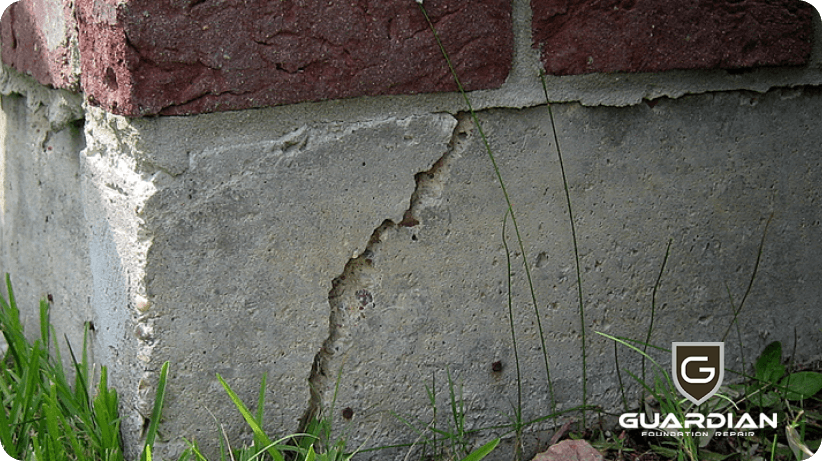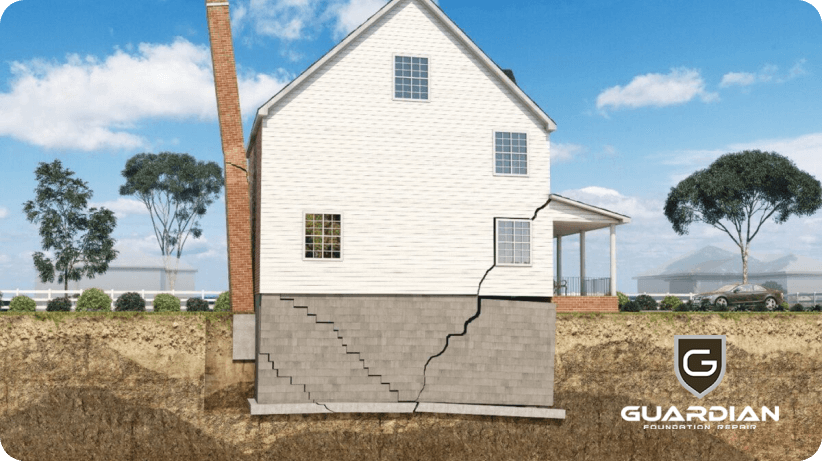Introduction:
Foundation cracks are a frequent issue in homes, often raising concerns about the structure’s stability and safety. Identifying the nature of these cracks is crucial, as some may simply be cosmetic, while others could signal significant structural problems.
Cosmetic cracks, often hairline in appearance, typically result from the natural shrinkage of concrete as it cures and does not threaten the home’s stability. However, structural cracks are different, indicating potential underlying issues that could compromise the foundation’s integrity if not addressed promptly.
In this comprehensive guide, we will explore the different causes and types of foundation cracks. We will also offer expert repair solutions for cracks in your home’s foundation walls or concrete slab, helping you maintain its structural integrity and safety.
What Are Foundation Cracks?
Foundation cracks are breaks or fissures in a home’s foundation’s walls or concrete slab. While some cracks are harmless, others can indicate serious structural problems that need attention.
In the first few years after a home is built, small hairline cracks may appear as the concrete cures. These cracks, usually less than 1/8 inch wide, are typically not a cause for concern. However, larger cracks or those that continue to grow over time could signal underlying issues.
Understanding the types of foundation movement that can cause cracks is important:
- Sinking: When the foundation moves downward, often due to soil compression.
- Heaving: When the foundation moves upward, which can happen due to expanding soil or other forces.
- Tilting: When the foundation walls tilt inward or outward, potentially causing uneven floors and other issues.
- Bowing: When part of the foundation wall protrudes outward, indicating pressure and potential structural failure.
If you notice new or expanding cracks in your foundation, getting a professional inspection is essential. A foundation repair specialist can assess the situation and recommend the appropriate crack foundation repair solutions. Early detection and repair can prevent further damage and ensure the safety and stability of your home.
Identifying the Root Causes of Foundation Cracks
Foundation cracks can result from various factors, each posing unique challenges. Understanding these causes can help identify and address foundation issues effectively.
Construction Issues
- Inadequate Soil Compaction: If the soil is not properly compacted before construction, the foundation may sink unevenly, leading to cracks and structural damage.
- Structural Additions: Adding extensions or significant renovations can increase the weight of the foundation, causing additional stress and potential cracking.
Expansive Soils
- Clay-Rich Soil: Soil with high clay content expands and contracts when wet. This constant movement can lead to significant foundation shifts and cracks.
Weather Variations
- Seasonal Changes: Foundations built on expansive soils are particularly vulnerable to seasonal changes. For instance, dry seasons followed by heavy rains can cause the soil to swell and shrink, leading to cracks.
- Frost Heave: In colder climates, water in the soil can freeze and expand, pushing the foundation upwards and causing cracks.
Poor Drainage Issue
- Water Accumulation: Poor drainage around the foundation can lead to water buildup. This increases hydrostatic pressure against the foundation walls, causing them to bow inward and crack.
Soil Movement
- Soil Creep: Homes built on slopes may experience gradual soil movement down the slope, leading to lateral shifts in the foundation and resulting cracks.
- Tree Roots: Growing tree roots can pressure the foundation, causing displacement and cracks.
- Seismic Activity: Earthquakes can apply sudden and significant stress to foundations, leading to cracks or more severe damage.
Heavy Excavation
- Nearby Excavation: Construction activities involving heavy excavation near a home can destabilize the foundation. This is similar to digging too close to a structure, which can lead to lateral movement and cracking.
All these factors contribute to foundation cracks by causing differential settlement, where different foundation parts settle unevenly. This uneven movement stresses the foundation, leading to cracks and other structural issues.
Different Types of Foundation Cracks And Repair Solutions
Foundation cracks come in various forms, each signaling different underlying issues. Understanding these types can help determine the appropriate foundation crack repair method.
Horizontal Foundation Cracks
Horizontal cracks can signal serious issues with your home’s foundation. They are often caused by soil pressure or water damage, particularly when present in basement walls. These cracks can weaken the structural integrity of your home. If left unaddressed, they can lead to bowing walls and water leakage into the basement, compromising your home’s stability and safety.
Repair Solutions:
Neglecting horizontal foundation cracks can result in severe damage. Here are some effective repair options that Foundation Repair Knoxville experts recommend:
- Interior or Exterior Drainage Systems: Installing these systems can help manage water around the foundation, reduce soil pressure, and prevent further damage.
- Epoxy Injection: This method involves injecting epoxy into the cracks to seal and restore the wall’s structural integrity.
- Carbon Fiber Straps: These straps are applied to the wall to reinforce and prevent further bowing.
- Steel I-Beams: These beams are installed inside the basement to support the compromised walls.
- Wall Anchors or Push Piers: These are used to stabilize and correct the position of the foundation walls, providing long-term support and preventing future movement.
Vertical Foundation Cracks
Vertical cracks in a foundation are relatively common and often less alarming than horizontal cracks. These cracks typically form when a foundation settles or shrinks during curing. While vertical cracks can allow some moisture intrusion, they are usually less severe and easier to manage than horizontal or diagonal cracks. These cracks often appear in poured foundations, running up and down the walls.
Repair Solutions:
- Epoxy Injections: Injecting epoxy into the cracks can seal them and restore the wall’s structural integrity.
- Polyurethane Injections: This method also fills and seals vertical cracks, offering a flexible solution that can handle slight foundation movements.
Although vertical cracks are generally not structurally severe, it’s important to monitor them if you notice the cracks worsening, contact crack foundation repair experts to assess your home’s stability and prevent further issues.
Stair Step Foundation Cracks
Stair step cracks are typically found in retaining walls or block foundations, often appearing along the mortar joints in a zigzag pattern. These cracks are caused by moisture problems and foundation sinking or settlement. When this occurs, the mortar joints of the blocks crack, following a stair-step pattern throughout the wall, indicating an underlying structural issue that requires attention.
Repair Solutions:
- Repointing Mortar Joints: Repairing the affected mortar joints and sealing the gaps with a waterproofing compound can help prevent moisture intrusion.
- Underpinning with Push Piers: In cases of severe differential settlement, underpinning the foundation with push piers may be necessary to stabilize and support the structure.
Diagonal Foundation Cracks
Most diagonal cracks are similar to vertical cracks and often result from the natural curing of concrete foundations. These cracks usually run at a 30-degree angle and can be easily repaired. However, diagonal cracks can sometimes indicate more serious structural stress or movement, appearing at a steeper 45-degree angle due to soil pressure, foundation settlement, or excessive moisture. If you notice diagonal cracks on your walls and foundation, it’s important to have them evaluated by a professional house foundation repair specialist to determine the cause and extent of the damage.
Repair Solutions:
- Epoxy Injection: For minor cracks, epoxy injection can fill and seal the cracks, restoring the structural integrity.
- Carbon Fiber Reinforcement: This method involves applying carbon fiber straps to the wall to reinforce it and prevent further movement.
- Underpinning with Piers: In cases of severe settlement, installing piers can lift and stabilize the settled part of the foundation.
Foundation Slab Cracks
Foundation slab cracks are long, often horizontal gaps that can run the length of the concrete slab. Poured concrete slabs are prone to developing cracks over time, typically more visible than shrinkage cracks. These cracks can appear in horizontal, vertical, diagonal, or stair-stepped patterns, leading to uneven or sloping floor surfaces. Common causes of slab cracks include soil settlement, temperature fluctuations, and improper curing.
Repair Options:
- Minor Cracks: For small cracks, patching, epoxy injections, or applying sealant can effectively address the issue and prevent further damage.
- Significant Gaps:
- High-Density Polyurethane Foam Injection: This method involves injecting foam beneath the slab to lift and level it, addressing uneven surfaces.
- Slab Replacement: If the damage is extensive, removing the damaged slab and pouring a new one may be necessary.
- Pier Installation: Installing piers can stabilize the foundation, preventing further settlement and structural damage.
Also learn about ceiling cracks and when you need a repair specialist.
How To Prevent Foundation Cracks
Most foundation problems are caused by water, so ensuring good drainage around your foundation is crucial to preventing cracks. Here are some effective strategies to keep your foundation intact:
- Regrade Your Yard: Ensure your yard slopes away from your home’s foundation. You can hire foundation repair contractors or landscapers to regrade it, or tackle it as a DIY project if you’re up to it.
- Clean Your Gutters Regularly: Clogged gutters can cause water to overflow and run down the side of the house, soaking into the ground near the foundation. Regularly cleaning your gutters helps prevent this.
- Install Downspout Extensions: Many downspouts are too short and dump water right next to the foundation. Installing extensions is an easy and inexpensive solution to channel water away from the foundation.
- Install Exterior Drain Tile: A perimeter drain installed around the outside of your foundation at the footer level helps channel excess water in the soil away from the foundation.
- Install Interior Drain Tile: Similar to an exterior drain tile, this system ensures the soil under the foundation doesn’t get oversaturated with water, further protecting your foundation from cracks.
Implementing these preventative measures can help protect your home’s foundation from water damage, minimizing the risk of cracks and maintaining the structural integrity of your property.
Professional Foundation Crack Repair to Protect Your Home Structure

Our team of dedicated professionals addresses structural and non-structural foundation cracks, ensuring your home remains secure and resilient. With our expertise, you can trust us to provide reliable solutions to preserve your home’s foundation.
Schedule a free inspection with Guardian Foundation Repair today. Let our experienced team provide peace of mind and the right solutions to keep your foundation strong and secure. Contact us for a quote and answers to your questions.


